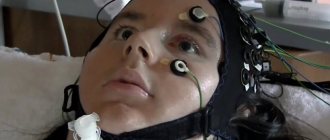Alcohol withdrawal syndrome is a common condition that occurs against the background of alcoholism. The difficulty of treating the patient is aggravated by the fact that the patient does not realize the severity of his situation and believes that he can stop drinking whenever he wants. As soon as the usual doses of alcohol stop entering the body, its physical condition and psycho-emotional background sharply deteriorate. Such conditions require hospitalization in a drug treatment clinic.
If you need emergency help, contact Alco-Center
Call the hotline +7 (495) 773-03-43 and our doctors will provide emergency care for intoxication of the body with breakdown products of alcohol and narcotic substances.
from 3,200 rub.
Withdrawal from binge drinking
Emergency body detoxification procedure
from 4,000 rub.
Coding
Urgent blocking of cravings for alcoholic beverages
from 68,000 rub.
Rehabilitation
Comprehensive rehabilitation giving 100% results
Treatment of withdrawal symptoms
Even if the severity of the disease is low, a comprehensive examination of the patient and consultation with a specialist is recommended. The course of therapy is carried out to prevent possible complications and heal existing concomitant diseases. At home, it is possible to relieve the primary manifestations of the disease and make you feel better, but there is no way to cure the addict. Over time, the craving for alcohol will resume, and the disease will manifest itself with renewed vigor. The hospital prescribes the following set of procedures:
- diagnosis and identification of the clinical picture;
- complete exclusion of alcohol intake;
- removal of toxins;
- treatment with medications;
- prescription of a vitamin complex;
- elimination of concomitant diseases;
- rehabilitation program.
Mild treatment is carried out on an outpatient basis or at home. Complex forms of the disease are accompanied by the presence of severe somatic symptoms, seizures, delirium tremens, mental disorders and require immediate hospitalization. In a hospital setting, treatment is carried out by a narcologist, with round-the-clock supervision by medical personnel. The patient is diagnosed and appropriate therapy is prescribed:
- Infusion therapy. Helps remove toxins and correct water and electrolyte processes. The patient is prescribed drips of saline solutions, dextrose, and hemodez.
- Benzodiazepines. Reduce anxiety, help reduce autonomic disorders.
- Neuroleptics. They help eliminate hallucinations, weaken psychomotor agitation, suppress feelings of fear and aggression.
- Beta blockers. Prescribed to relieve tension and prevent angina attacks.
- Antidepressants. Justified in cases where it is necessary to relieve affective disorders and depressive states.
- Vitamins. Helps improve metabolic processes and nervous system function.
In addition to general procedures, the patient is prescribed a special diet, plasmapheresis and other types of therapy. After this, the patient can undergo a rehabilitation course, with consultation of a psychotherapist and assistance in socialization.
Stages of withdrawal syndrome
In the second stage of alcoholism, there are three stages of withdrawal syndrome.
1. Vegetative-asthenic disorders. In this case, symptoms of excitation of the sympathetic nervous system appear: hyperhidrosis, rapid heartbeat, thirst and dry mucous membranes. At this stage, it is possible to control the craving for alcohol through willpower and lead a full social life.
2. Autonomic-somatic and neurological disorders.
- Chronic dilation of the blood vessels of the skin (especially the face) and the membranes of the eyes.
- Hypotension
- Increased intracranial pressure (feels like heaviness).
- Loss of coordination of movements: hand tremors, unsteadiness of gait.
- Vomit
The desire to hangover becomes uncontrollable. Binge drinking is often observed.
3. Mental disorders. When you stop drinking alcohol, anxiety and fear, melancholy and guilt appear. Insomnia and frequent nightmares occur. The patient becomes irritable, sometimes aggressive.
For the third stage of alcoholism, it is impossible to distinguish stages of withdrawal syndrome, since there is a wide range of somatic and mental symptoms, manifested in different intensities and in different combinations.
What is alcohol withdrawal
Alcohol withdrawal syndrome is a complex of disorders that appears in an alcohol addict when he stops drinking alcohol completely or sharply reduces the dose. Manifested by the presence of vegetative, neurological, somatic and mental disorders.
Withdrawal occurs when abstaining from regular excessive use of various drugs, when the body gets used to these substances and cannot function normally without the usual dose. Alcohol withdrawal is the most common; it occurs against the background of already formed alcohol dependence of the second stage.
After prolonged alcohol abuse, the patient develops a deficiency of neurotransmitters, which is compensated by the synthesis of catecholamines. When alcohol stops entering the body, catecholamines are no longer released. The activity of enzymes in the brain changes, the hormone dopamine accumulates and exceeds the norm. Its increase provokes the development of withdrawal syndrome. When the norm is exceeded three times, acute mental disorders appear.
Overexcitation of the autonomic nervous system and excess hormones secreted by the adrenal glands lead to deterioration in the functioning of the parts of the brain that are responsible for memory processes and the emotional sphere. The toxic effects of elevated levels of catecholamines lead to cardiac arrhythmia or fibrillation, which can be fatal.
If the patient has abused alcoholic beverages for 2-7 years, alcohol withdrawal develops. This happens when a person is in the second stage of alcoholism. For women, this period is much shorter - from three years. A sharp reduction in the period of abstinence development to 1-3 years is observed in adolescents. This is due to a hereditary predisposition or early onset of alcohol consumption. It appears within 6-48 hours after the last drink, and can last from 2-3 days to several weeks.
Addiction can occur when a person starts drinking alcohol again after treatment or long-term abstinence. Hangover symptoms renew against the background of a relapse, and a clinical picture of the same degree is observed at which the remission began.
What is the difference between withdrawal and hangover?
First of all, withdrawal syndrome does not only apply to alcohol addiction. Withdrawal syndrome refers to both drug withdrawal and the unpleasant symptoms that occur when quitting tobacco. And the concept of hangover syndrome refers only to alcohol addiction.
It is alcohol withdrawal syndrome that is called a true hangover. And it is a sign of the development of alcoholism. This concept means that when an addict stops drinking alcohol, their well-being sharply worsens. Taking the next dose of alcohol temporarily relieves painful symptoms.
Symptoms of alcohol withdrawal syndrome
Symptoms of the disease are not the same for everyone; each patient has different manifestations of somatic disorders and mental illnesses. They occur in varying degrees of severity and intensity. The reasons are very different and depend on the following factors:
- duration of the binge;
- stages of alcoholism;
- individual characteristics of the body;
- health conditions;
- age;
- number of drinks consumed.
The clinical picture separates two types of disorders - asthenic and affective. Asthenic disorders are irritability, weakness, decreased concentration, vegetative symptoms and tremor. Affective disorders include fears, anxiety, mood swings, outbursts of rage, and hysteria.
Minor signs begin to appear even before the disappearance of ethanol from the blood plasma, and are expressed in mild irritability and negativism. Severe cases are accompanied by convulsions, epileptic seizures, hallucinations or alcoholic delirium - the so-called “delirium tremens”. Observed in people who have repeatedly gone on a binge or experienced withdrawal symptoms. Signs of chronic intoxication of the central nervous system are as follows:
- sleep disturbance: impetuousness, anxiety, restless dreams;
- hyperacusis - when sounds seem too strong, loud, irritatingly sharp;
- auditory, tactile, visual hallucinations;
- sweating;
- guilt;
- tremor (shaking) of the hands, body or its individual parts;
- impaired coordination of movements;
- lack of appetite, disruptions in the gastrointestinal tract;
- tachycardia, arrhythmia, increased blood pressure;
- rhythmic twitching, eye movement characterized by high frequency (nystagmus);
- anxiety, mood swings, depression;
- epileptic seizures.
Depending on the clinical picture of the course of the disease and the severity of the processes, withdrawal syndrome is subject to the following classification:
First degree. It appears during short-term binges, which usually last no more than 2-3 days. The patient feels profuse sweating, dry mouth, and increased heart rate. Often there is a violation of coordination, orientation in time and space.
Second degree. After binge drinking for 3-10 days, the symptoms are expressed by the presence of not only vegetative, but also neurological problems, in which high blood pressure appears, the functioning of the gastrointestinal tract is disrupted, arrhythmia, tremor of the tongue, hands, eyelids, and various parts of the body appear. Such signs appear in patients who are in the second stage of alcoholism.
Third degree. The duration of the binge is 7-10 days or more. Somatic and vegetative disorders do not disappear, they fade into the background and are supplemented by mental problems. The most pronounced symptoms are anxiety, aggression, nightmares, mood swings, and suicidal tendencies. Characteristic during the transition of the second degree of alcoholism to the third.
The situation is aggravated by the presence of alcoholic delirium. Most often, delirium tremens appears within three days after stopping drinking alcohol, much less often after 4-6 days. The first signs are the appearance of anxiety, sleep disturbance, nightmares, mood changes. This is followed by serious somatic disorders, increased body temperature and blood pressure. Attacks of auditory, tactile, and visual hallucinations appear. Fear caused by visions induces the sufferer to commit actions that pose a danger to the person himself and others, which often becomes the cause of injury or suicide. The mortality rate due to delirium tremens is 1-5%. In this case, hospitalization of the patient is required.
Depending on the course of the disease and the prevailing symptoms, withdrawal syndrome is classified as follows:
- Neurovegetative. It manifests itself as insomnia, loss of appetite, fluctuations in blood pressure, tremors, and sweating.
- Somatic. Accompanied by pathology of internal organs (gastrointestinal tract disorders, cardiovascular diseases).
- Cerebral. Disorders of the autonomic nervous system are complemented by nystagmus.
- Psychopathological. Anxiety, fear, and hallucinations arise. Possible loss of orientation in time and space.
Types of Withdrawal – 4 Most Common Types of Withdrawal Syndrome
The disease is divided into groups and each type has its own symptoms and certain treatment methods are effective. For example, sexual addiction requires the work of psychologists and psychiatrists. It is almost impossible to get rid of addiction to alcohol without drug addiction treatment.
Types of withdrawal depending on addiction:
- narcotic;
- alcoholic;
- sexy;
- nicotine
Alcohol withdrawal
The syndrome appears in people who abuse alcohol. Alcohol withdrawal is the term used by doctors to define a chronic form of addiction.
Alcohol withdrawal syndrome manifests itself:
- nausea and gastrointestinal upset;
- apathy;
- memory impairment.
Severe forms of alcohol withdrawal are characterized by the same symptoms with additional, more severe additions:
- hallucinations;
- disorientation in space;
- convulsions;
- loss of consciousness.
Interesting! Strong alcohol is eliminated from the body in up to 2 months. During this period of time, brain cells are destroyed. As a result, the more and more often a person drinks, the more his cognitive abilities suffer. Gradually, the addict ceases to be aware of his actions.
Sexual withdrawal
This is a condition in which a person is forced or voluntarily refuses sexual activity. In the first phase, symptoms of prolonged abstinence are manifested by emotional instability, increased sweating and a feeling of discomfort in the lower hours. Long-term refusal of sex is manifested by hormonal imbalance and decreased libido.
Unlike drug and alcohol withdrawal, sexual withdrawal leads to health problems for both women and men. Prolonged abstinence has a negative impact on the psychological state and increases the risk of cancer, adenoma and prostatitis.
A sexologist will help you avoid the consequences of sexual withdrawal. Young people will be able to restore their normal intimate life immediately after completing the course of therapy. Middle-aged people (over 40 years old) need about 2-3 months to recover.
Drug withdrawal
From the use of drugs, people experience pleasure, joy and feel omnipotent. Drugs cause the body to produce much greater amounts of the “happy hormone” endorphin than it normally would. A sharp refusal leads to the fact that the body becomes unable to synthesize a number of vital hormones.
Drug withdrawal syndrome occurs 1-2 days after stopping taking illicit substances. The heavier the drug taken, the more pronounced the manifestations of abstinence will be.
Symptoms of drug withdrawal are considered the most severe and manifest themselves:
- pain throughout the body;
- heart rhythm disturbances;
- pale skin;
- causeless fear;
- panic attacks;
- epileptic seizures;
- nausea and vomiting;
- nervous overexcitation.
Many of the manifestations can cause death in the patient. You can cope with a severe form of addiction if you consult a narcologist in time. He will create an individual rehabilitation program and help reduce the manifestations of withdrawal symptoms.
Traditional medicine and independent actions will not help overcome drug withdrawal syndrome. In order to prevent complications, breakdown and improve the patient’s condition, you should definitely contact experienced doctors.
Nicotine withdrawal
Quitting nicotine does not manifest itself abruptly, as with drug addiction. Signs of withdrawal syndrome disappear or reduce their severity after 4-5 weeks. Symptoms that a smoker experiences during the period of quitting nicotine:
- increased appetite;
- coughing;
- dyspnea;
- sweating;
- tingling in the heart area.
Nicotine very quickly forms an addiction, as it spreads throughout all tissues, systems and organs. The habit is due to the fact that nicotine affects the functioning of the adrenal glands. Forcing them to secrete greater amounts of the hormone adrenaline and dopamine, which are responsible for performance and mood.
Nicotine withdrawal goes through the following stages in its development:
- Stage 1 (the first day of abstinence) – the smoker becomes irritable and has a strong desire to smoke;
- Stage 2 (several days) – problems with digestion appear, cravings for sweets increase, problems with sleep arise;
- Stage 3 (several weeks) – an annoying strong cough torments you, thoughts constantly arise to resume smoking.
The severity of this form of withdrawal symptom depends on the length of smoking. So, for example, in novice smokers, only one of the symptoms may predominate, while in heavy smokers, all of them will appear at once.
What is the difference between a hangover and withdrawal symptoms?
In both cases, a person experiences severe thirst, nausea, vomiting, headache and other similar symptoms. But there are a number of signs that help distinguish withdrawal from a post-intoxication state. These include:
- irritability and depression;
- internal tension;
- motor restlessness;
- strong desire to drink alcohol.
A hangover is observed in absolutely healthy people with severe intoxication of the body with alcohol or in an addict who is in the first stage of alcoholism. Symptoms weaken as ethanol breakdown products are removed from the body, and the person returns to normal life. There is no craving for drinking alcohol again; it only gets worse with consumption.
Withdrawal syndrome differs in the intensity of symptoms and their duration. It appears in alcohol addicts with the second or third stage of alcoholism. If the hangover goes away within a few hours, then the withdrawal syndrome lasts several days and is accompanied by an irresistible craving for alcohol. Taking a new dose of alcohol helps to relieve symptoms of malaise for a short time.
Disruption of the body's systems can cause the development of chronic diseases and even lead to death. If the disease is not treated promptly, the following complications may develop:
- renal or liver failure, cholecystitis, pancreatitis, liver cirrhosis;
- diseases of the cardiovascular system (cardiomyopathy, muscular dystrophy);
- internal bleeding (stomach, intestinal);
- somatic, mental disorders;
- alcoholic delirium;
- cerebral edema with fatal outcome.









